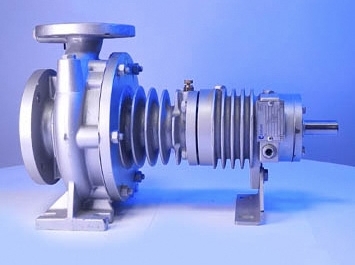November 2021 — Prom-nasos.com.ua

Wilo VeroLine Pump IPL50/160-0,55/4-IE1 (122033998) with a power of 0.55 kW - with a dry rotor, Inline, with a threaded or flanged connection. They are used in heating, air conditioning and cooling systems, for pumping water, water-glycol mixtures without abrasive substances. The mechanical seal is sliding, single, bellows type, in the AQEGG standard. R-MG1-17, adopted by our craftsmen, has proven itself well as an inexpensive and reliable alternative to the original seal 122097593 .
November 15, 2021
Centrifugal pumps for hot liquids, oils 350С

In various fields of industry and production, for hot oil circulation, boiler thermal oil pumping.
For high-temperature heat carriers, which are used in industrial spheres as part of technological installations for processing petroleum products or stand-alone stationary, modular and transportable boiler houses used in heat supply systems using diathermic oil as a heat carrier.
November 11, 2021
Replacement of Calpeda NM 40/16CE End Pump Seal

NM pumps manufactured by Calpeda are centrifugal monoblock pumps with a vertical pressure nozzle, a horizontal suction nozzle, and a horizontally positioned shaft. It is used to raise pressure in water supply systems in domestic and industrial networks, in fire-fighting installations, in air conditioning and cooling systems. Cantilever pumps NM 40/16CE are equipped with a mechanical seal R3-X6H62V6 D20 16006040000 , designed for clean non-abrasive liquids with temperatures from -10 °C to +90 ° C. Our specialists have replaced the original mechanical seal with a seal in the materials Graphite/ Silicon carbide / Viton , since such materials are better suited for the vegetable oil medium.

Chemical pump housings, which are presented in our the store can be made from a variety of materials for the buyer's choice, including PP (polypropylene), GFRPP (polypropylene with glass fiber), CFRPP (polypropylene with carbon fiber), PVDF (polyvinylidene difluoride), GFRETFE (Ethylenetetrafluoroethylene, glass fiber reinforced ETFE), CFRETFE (Carbon fiber ETFE) and PTFE .
Among the materials from which the flow parts of chemical pumps are made, polypropylene (PP) has long occupied a prominent place. Such a wide application is due to its relative versatility and cheapness. Polypropylene has a good balance of properties and cost, which most thermoplastics do not achieve. Polypropylene provides easy processing, excellent chemical resistance and good mechanical properties.
However, there are two characteristics in which it is significantly inferior to metals – mechanical resistance and maximum operating temperature.
Relative volumetric abrasive abrasion of various materials in accordance with the method of studying abrasive wear in an abrasive mixture (ISO 15527) – lower values are preferable.
Glass fiber (GFRP) and carbon fiber (CFRP) reinforcement technologies have been developed to improve these performance.
CFRP and GFRP plastics differ primarily in the use of different fibers. Plastics with the addition of carbon fibers have significantly higher strength, and are also lighter due to lower density. CFRP is five times lighter than steel and has only about 60 percent of the weight of aluminum and is used where other materials reach the limit of their load-bearing capacity . Also important properties of CFRP are its high stability, low thermal expansion, and X-ray transparency. The advantage of plastics with the addition of fiberglass is a lower cost and slightly higher resistance to shock loads and shear.
There are no restrictions on the possible use of CFRP. The most common applications of CFRP are aerospace, automotive, and wind power. CFRP is also used in medical engineering, robotics, automation technologies, measurement technology and optics, as well as in Mechanical Engineering and in the sports and recreation sector.
GFRP glass fiber reinforced polypropylene (PP) has better tensile strength, tensile elasticity, higher maximum operating temperature (70°C), better dimensional stability when forming with reduced tensile strength.
Significantly better performance in terms of chemical and mechanical and temperature stability can be achieved by using polyvinylidene difluoride – PVDF as the pump part material. This material has good abrasion resistance, the highest tensile strength of all fluorocarbons except ethylene tetrafluoroethylene ETFE. Good overall chemical resistance and maximum operating temperature up to 95°C. The disadvantages of this material are the high cost, the inability to use reinforcing fibers and poor resistance to concentrated smoky acids.
Ethylenetetrafluoroethylene-ETFE has significant advantages over PVDF. Even at low temperatures, it has high impact strength and is quite rigid by fluoropolymer standards. It can be reinforced with glass fiber and carbon fiber, providing even higher mechanical performance. It has the highest tensile strength similar to polypropylene. Its chemical resistance is not inferior, although not as good as that of PTFE, especially to ketones and halogenated hydrocarbons.
Glass fiber reinforced (GFRETFE) or carbon fiber reinforced (CFRETFE) ethylene tetrafluoroethylene has increased tensile strength, tensile modulus, higher resistance to high temperatures, and less linear expansion compared to unmodified ETFE.
PP / GFRPP material can withstand temperatures up to 75 ℃. PVDF material can withstand temperatures up to 95 ℃. CFRETFE material can withstand temperatures up to 150 ℃.
The correct choice of pump housing material depends on the type of chemical that the equipment will pump and its concentration.
● – excellent
○ – good
△ – satisfactory
× - bad
4 posts





























































































































